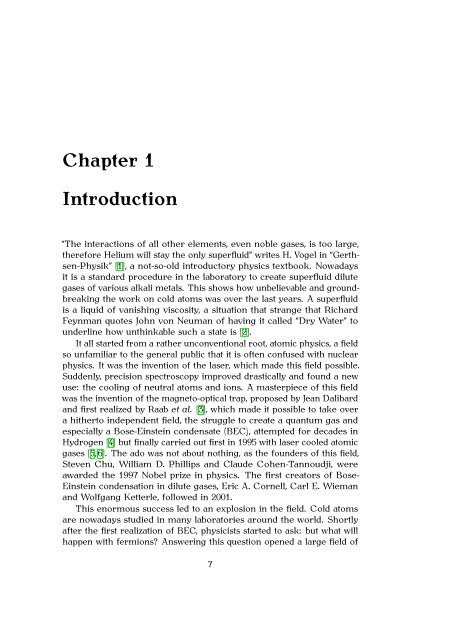Martin Teichmann Atomes de lithium-6 ultra froids dans la ... - TEL
Martin Teichmann Atomes de lithium-6 ultra froids dans la ... - TEL
Martin Teichmann Atomes de lithium-6 ultra froids dans la ... - TEL
Create successful ePaper yourself
Turn your PDF publications into a flip-book with our unique Google optimized e-Paper software.
Chapter 1<br />
Introduction<br />
“The interactions of all other elements, even noble gases, is too <strong>la</strong>rge,<br />
therefore Helium will stay the only superfluid” writes H. Vogel in “Gerthsen-Physik”<br />
[1], a not-so-old introductory physics textbook. Nowadays<br />
it is a standard procedure in the <strong>la</strong>boratory to create superfluid dilute<br />
gases of various alkali metals. This shows how unbelievable and groundbreaking<br />
the work on cold atoms was over the <strong>la</strong>st years. A superfluid<br />
is a liquid of vanishing viscosity, a situation that strange that Richard<br />
Feynman quotes John von Neuman of having it called “Dry Water” to<br />
un<strong>de</strong>rline how unthinkable such a state is [2].<br />
It all started from a rather unconventional root, atomic physics, a field<br />
so unfamiliar to the general public that it is often confused with nuclear<br />
physics. It was the invention of the <strong>la</strong>ser, which ma<strong>de</strong> this field possible.<br />
Sud<strong>de</strong>nly, precision spectroscopy improved drastically and found a new<br />
use: the cooling of neutral atoms and ions. A masterpiece of this field<br />
was the invention of the magneto-optical trap, proposed by Jean Dalibard<br />
and first realized by Raab et al. [3], which ma<strong>de</strong> it possible to take over<br />
a hitherto in<strong>de</strong>pen<strong>de</strong>nt field, the struggle to create a quantum gas and<br />
especially a Bose-Einstein con<strong>de</strong>nsate (BEC), attempted for <strong>de</strong>ca<strong>de</strong>s in<br />
Hydrogen [4] but finally carried out first in 1995 with <strong>la</strong>ser cooled atomic<br />
gases [5, 6]. The ado was not about nothing, as the foun<strong>de</strong>rs of this field,<br />
Steven Chu, William D. Phillips and C<strong>la</strong>u<strong>de</strong> Cohen-Tannoudji, were<br />
awar<strong>de</strong>d the 1997 Nobel prize in physics. The first creators of Bose-<br />
Einstein con<strong>de</strong>nsation in dilute gases, Eric A. Cornell, Carl E. Wieman<br />
and Wolfgang Ketterle, followed in 2001.<br />
This enormous success led to an explosion in the field. Cold atoms<br />
are nowadays studied in many <strong>la</strong>boratories around the world. Shortly<br />
after the first realization of BEC, physicists started to ask: but what will<br />
happen with fermions? Answering this question opened a <strong>la</strong>rge field of<br />
7

















